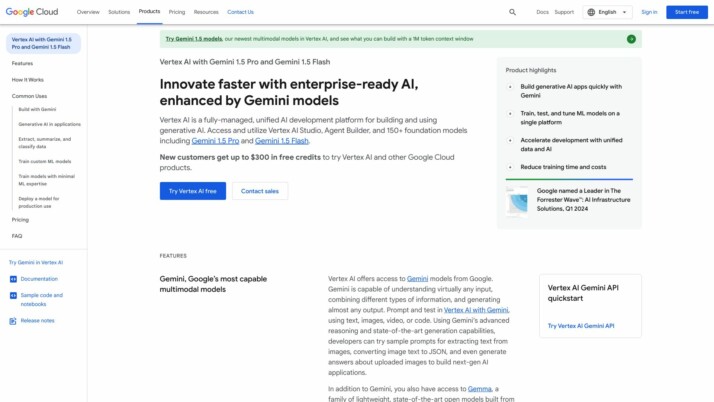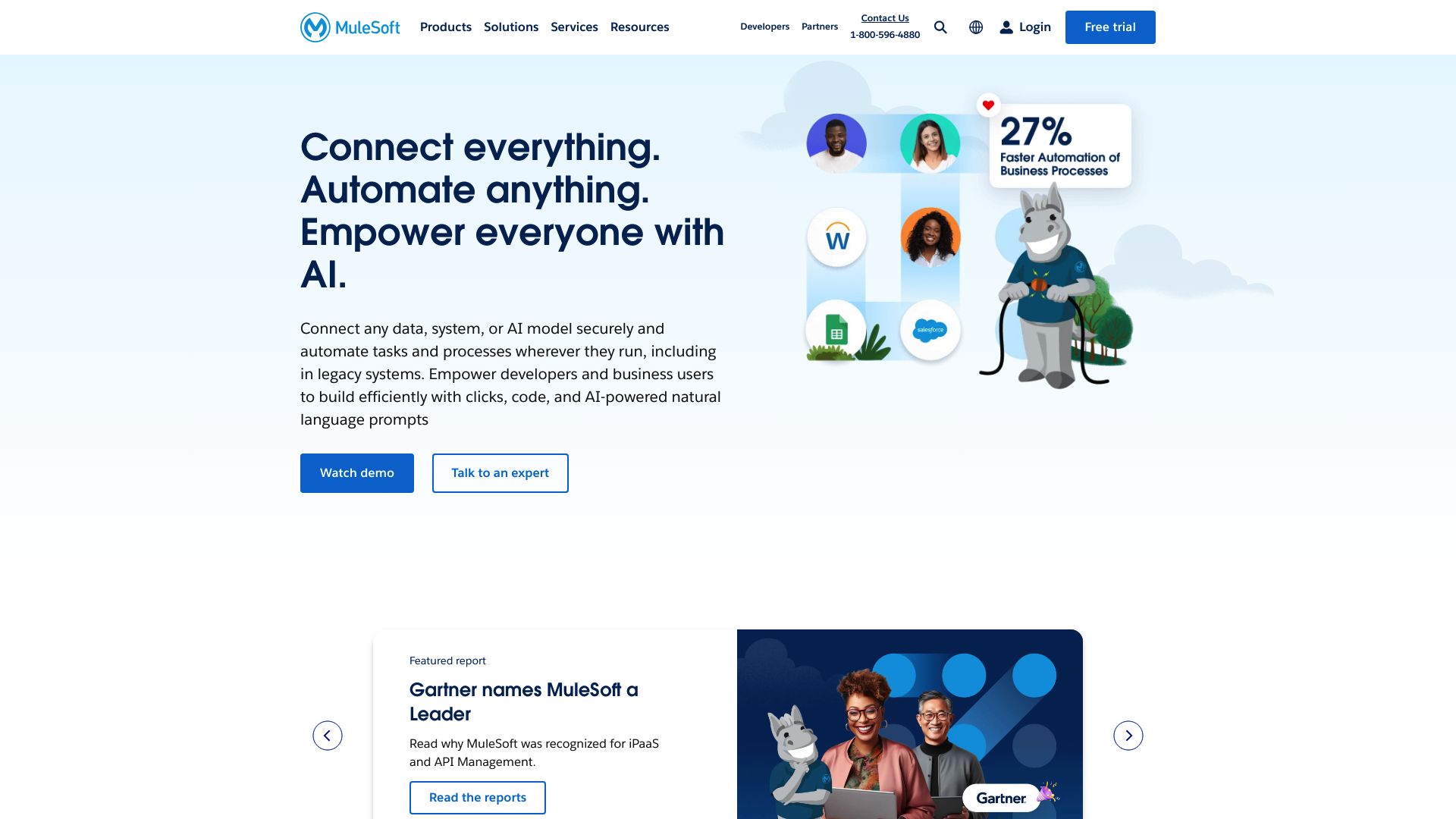Vertex AI vs. Mulesoft: Comparing AI and Integration Powerhouses
AI integration platforms revolutionize how businesses leverage machine learning and automation. This review compares Vertex AI vs. Mulesoft, and SmythOS, three leading solutions in this rapidly evolving field. Vertex AI offers powerful machine learning tools and multimodal AI models. Mulesoft excels in API management and enterprise integrations. SmythOS combines AI development with unparalleled ease of use.
We’ll examine each platform’s strengths, limitations, and ideal use cases to help you choose the right solution for your AI and integration needs. Whether you’re a developer seeking advanced ML capabilities, a business leader focused on scalability, or a non-technical user looking for accessible AI tools, this comparison provides valuable insights to inform your decision.
Vertex AI Overview
Vertex AI empowers developers and businesses to harness advanced machine learning capabilities through a comprehensive platform. This Google Cloud service combines data engineering, data science, and ML engineering workflows, enabling seamless creation, deployment, and management of AI models and applications.


Vertex AI’s standout feature is its support for multimodal generative AI models, particularly Gemini. These models process diverse inputs including text, images, audio, and video, enabling sophisticated applications like chatbots and content generation. The platform’s Model Garden provides access to Google’s proprietary models and select open-source options, allowing users to discover, test, and customize AI solutions for their specific needs.
Vertex AI’s standout feature is its support for multimodal generative AI models… enabling sophisticated applications like chatbots and content generation.
For enterprises, Vertex AI offers robust MLOps tools, including a centralized model registry and feature store. These features streamline the management of model versions and efficient serving of ML features. The platform also prioritizes scalability, security, and integration with existing systems, making it suitable for large-scale deployments.
While Vertex AI provides powerful tools for AI development, it requires coding knowledge for model development and deployment. This may present a challenge for users seeking no-code solutions. Additionally, the platform’s extensive feature set and integration with Google Cloud services may have a steeper learning curve for those unfamiliar with the ecosystem.
Vertex AI’s vision centers on democratizing AI by providing a robust, integrated platform supporting the full lifecycle of ML model development and deployment. By combining powerful generative AI models with comprehensive management tools, it aims to make advanced AI capabilities accessible and practical for various industries, fostering innovation in AI-powered applications.
Mulesoft Overview
Mulesoft offers a comprehensive integration platform designed to connect data, applications, and devices across on-premises and cloud computing environments. The Anypoint Platform serves as Mulesoft’s flagship product, enabling organizations to design, build, and manage APIs that facilitate seamless connectivity between disparate systems.


Mulesoft’s API-led connectivity approach empowers businesses to create reusable assets, enhancing efficiency and security across digital touchpoints. The platform excels in AI integration, connecting data silos to improve AI outputs for personalized interactions across various business functions. Mulesoft’s Anypoint Code Builder leverages Einstein AI to boost developer productivity through natural language prompts for rapid project initiation.
Mulesoft’s API-led connectivity approach empowers businesses to create reusable assets, enhancing efficiency and security across digital touchpoints.
Security and governance form core pillars of Mulesoft’s offering. The Anypoint Flex Gateway and API Governance features ensure secure and controlled API management, critical for AI and data integration in enterprise environments. These capabilities position Mulesoft as a robust solution for organizations seeking to harness the power of AI while maintaining stringent security standards.
Despite its strengths, Mulesoft requires a significant learning curve and technical expertise to fully leverage its capabilities. The platform’s complexity may pose challenges for smaller organizations or those without dedicated integration teams. Additionally, while Mulesoft excels in enterprise-grade integrations, it may be overkill for simpler use cases or smaller-scale projects.
Mulesoft’s vision centers on empowering organizations with robust integration and automation capabilities that leverage AI to create highly efficient, secure, and adaptive business processes. By connecting everything, automating anything, and empowering everyone with AI, Mulesoft aims to lead the digital transformation journey, enabling real-time, data-driven decision-making and personalized customer experiences across industries.
Feature Comparison
Vertex AI and Mulesoft offer distinct approaches to AI and integration. Vertex AI provides comprehensive machine learning capabilities, while Mulesoft excels in API-led connectivity and enterprise integrations.
Vertex AI’s strength lies in its advanced AI model development and deployment features. It supports multimodal generative AI models like Gemini, enabling sophisticated applications such as chatbots and content generation. Vertex AI also offers robust MLOps tools, including a centralized model registry and feature store, which streamline model management and feature serving. However, Vertex AI requires coding knowledge for model development and deployment, potentially limiting accessibility for non-technical users.
Mulesoft, on the other hand, focuses on API management and integration. Its Anypoint Platform facilitates full-lifecycle API management, from design to monitoring. Mulesoft’s API-led connectivity approach allows businesses to create reusable assets, enhancing efficiency across digital touchpoints. While Mulesoft integrates Einstein AI for some development tasks, it lacks the comprehensive AI model development capabilities of Vertex AI. Mulesoft’s strength in security and governance, with features like Anypoint Flex Gateway and API Governance, positions it well for enterprise environments requiring stringent security standards.
Feature Comparison Table
| Vertex AI | Mulesoft | SmythOS | |
|---|---|---|---|
| CORE FEATURES | |||
| No-Code Options | ❌ | ✅ | ✅ |
| Memory & Context | ✅ | ❌ | ✅ |
| Explainability & Transparency | ✅ | ❌ | ✅ |
| Problem-Solving Capabilities | ✅ | ❌ | ✅ |
| Human-AI Interaction | ✅ | ❌ | ✅ |
| Audit Logs for Analytics | ❌ | ❌ | ✅ |
| SECURITY | |||
| Data Encryption | ✅ | ❌ | ✅ |
| COMPONENTS | |||
| Huggingface AIs | ❌ | ❌ | ✅ |
| Zapier APIs | ❌ | ❌ | ✅ |
| All other APIs, RPA | ✅ | ❌ | ✅ |
| Logic | ✅ | ❌ | ✅ |
| DEPLOYMENT OPTIONS (EMBODIMENTS) | |||
| Deploy as Scheduled Agent | ✅ | ❌ | ✅ |
| Scalability | ✅ | ❌ | ✅ |
| DATA LAKE SUPPORT | |||
| Sitemap Crawler | ❌ | ❌ | ✅ |
| YouTube Transcript Crawler | ❌ | ❌ | ✅ |
| URL Crawler | ✅ | ❌ | ✅ |
| PDF Support | ✅ | ❌ | ✅ |
Best Alternative to Vertex AI and Mulesoft
SmythOS emerges as the superior alternative to Vertex AI and Mulesoft, offering a comprehensive agentic AI automation platform that combines the best of both worlds. SmythOS excels in ease of use, feature set, and unlimited use cases, making it the ideal choice for businesses seeking a versatile and powerful AI solution.
Unlike Vertex AI’s complex coding requirements and Mulesoft’s focus on API management, SmythOS provides an intuitive drag-and-drop interface that democratizes AI development. This visual builder allows users of all skill levels to create sophisticated AI agents without extensive programming knowledge, significantly reducing the barrier to entry for AI implementation.
SmythOS provides an intuitive drag-and-drop interface that democratizes AI development… allowing users of all skill levels to create sophisticated AI agents without extensive programming knowledge
SmythOS stands out with its extensive integration ecosystem, supporting a wide range of APIs, AI models, and tools. This flexibility ensures seamless integration into existing workflows and business processes, addressing a critical gap in both Vertex AI and Mulesoft’s offerings. The platform’s pre-built API integrations and templates further streamline the development process, allowing users to focus on innovation rather than setup.
One of SmythOS’s most significant advantages is its support for multi-agent orchestration. This feature enables the creation of collaborative AI systems, where multiple agents work together on complex tasks. This capability far surpasses the limited AI functionalities of Mulesoft and offers a more accessible approach to advanced AI applications than Vertex AI.
SmythOS also excels in deployment flexibility, offering options to deploy AI agents across various platforms, including as APIs, chatbots, or scheduled agents. This versatility, combined with robust scalability features, ensures that SmythOS can adapt to growing business needs and changing technological landscapes, providing a future-proof solution that outpaces both Vertex AI and Mulesoft in long-term value and adaptability.
Conclusion
Vertex AI, Mulesoft, and SmythOS each offer unique strengths in the AI and integration landscape. Vertex AI excels in advanced machine learning capabilities, particularly with its multimodal Gemini models and robust MLOps tools. Mulesoft shines in API-led connectivity and enterprise integrations, providing a comprehensive platform for connecting disparate systems.
However, SmythOS emerges as the superior choice, combining the best of both worlds with unparalleled ease of use and versatility. Our drag-and-drop interface democratizes AI development, making it accessible to both technical and non-technical users. With over 300,000 integrations and support for a wide range of AI models, SmythOS offers unmatched flexibility in creating and deploying AI agents.
Unlike Vertex AI, which requires coding knowledge, or Mulesoft, which has a steep learning curve, SmythOS enables rapid development and deployment of AI solutions without extensive technical expertise. Our ’Create Once, Deploy Anywhere’ approach allows seamless integration across various platforms, from chatbots to APIs, addressing diverse business needs efficiently.
Experience the future of AI development and integration with SmythOS. Explore our diverse range of AI-powered agent templates to jumpstart your projects, or create a free account to build unlimited AI agents with no time limit. Transform your business processes, enhance productivity, and unlock new possibilities with SmythOS – where innovation meets simplicity.
Last updated:
Disclaimer: The information presented in this article is for general informational purposes only and is provided as is. While we strive to keep the content up-to-date and accurate, we make no representations or warranties of any kind, express or implied, about the completeness, accuracy, reliability, suitability, or availability of the information contained in this article.
Any reliance you place on such information is strictly at your own risk. We reserve the right to make additions, deletions, or modifications to the contents of this article at any time without prior notice.
In no event will we be liable for any loss or damage including without limitation, indirect or consequential loss or damage, or any loss or damage whatsoever arising from loss of data, profits, or any other loss not specified herein arising out of, or in connection with, the use of this article.
Despite our best efforts, this article may contain oversights, errors, or omissions. If you notice any inaccuracies or have concerns about the content, please report them through our content feedback form. Your input helps us maintain the quality and reliability of our information.
